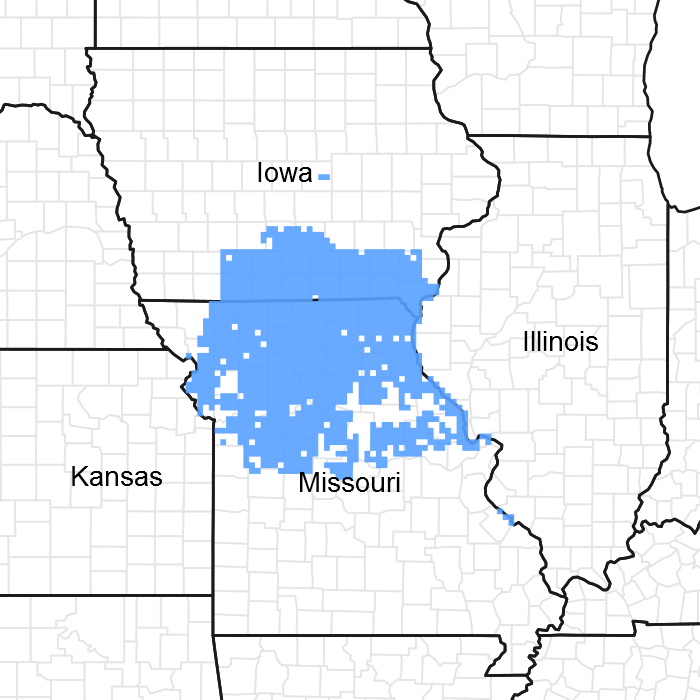
Natural Resources
Conservation Service
Ecological site R109XY031MO
Wet Floodplain Prairie
Last updated: 7/02/2024
Accessed: 12/22/2025
General information
Provisional. A provisional ecological site description has undergone quality control and quality assurance review. It contains a working state and transition model and enough information to identify the ecological site.

Figure 1. Mapped extent
Areas shown in blue indicate the maximum mapped extent of this ecological site. Other ecological sites likely occur within the highlighted areas. It is also possible for this ecological site to occur outside of highlighted areas if detailed soil survey has not been completed or recently updated.
MLRA notes
Major Land Resource Area (MLRA): 109X–Iowa and Missouri Heavy Till Plain
The Iowa and Missouri Heavy Till Plain is an area of rolling hills interspersed with interfluve divides and alluvial valleys. Elevation ranges from about 660 feet along the lower reaches of rivers, to about 980 feet on stable interfluve summits in southern Iowa. Relief is about 80 to 160 feet between major streams and adjacent interfluve summits. Most of the till plain drains south to the Missouri River via the Grand and Chariton River systems, but the northeastern portion drains southeast to the Mississippi River. Loess caps the pre-Illinoisan aged till on interfluves, whereas the till is exposed on side slopes. Mississippian aged limestone and Pennsylvanian aged sandstone and shale crop out on lower slopes in some areas.
Classification relationships
Terrestrial Natural Community Type in Missouri (Nelson, 2010):
The reference state for this ecological site is most similar to a Wet Bottomland Prairie.
National Vegetation Classification System Vegetation Association (NatureServe, 2010):
The reference state for this ecological site is most similar to Spartina pectinata - Carex spp. - Calamagrostis canadensis - Lythrum alatum - (Oxypolis rigidior) Herbaceous Vegetation (CEGL002224).
Geographic relationship to the Missouri Ecological Classification System (Nigh & Schroeder, 2002):
This ecological site occurs throughout the Central Dissected Till Plains Section.
Ecological site concept
NOTE: This is a “provisional” Ecological Site Description (ESD) that is under development. It contains basic ecological information that can be used for conservation planning, application and land management. As additional information is collected, analyzed and reviewed, this ESD will be refined and published as “Approved”.
Wet Floodplain Prairies are widespread in floodplains throughout the MLRA and adjacent areas. Typically, this ecological site occupies most of the floodplain between Terrace sites and the ribbon of Floodplain Forest sites along the stream channel. On larger floodplains, it occupies low areas in the floodplain associated with former meander scars, tributary stream channels and backwater lowlands between natural levees of these once dynamic rivers. Here they are often associated with Ponded Floodplain Prairies on lower areas, and Wet Floodplain Woodland sites on higher areas. Soils are very deep, seasonally wet, and subject to flooding. The reference plant community is prairie dominated by a dense cover of wetland species, including prairie cordgrass, sedges, and wetness-tolerant forbs.
Associated sites
| F109XY030MO |
Loamy Floodplain Forest Loamy Floodplain Forest sites are often in adjacent, natural levee positions between this site and the active stream channel. |
|---|---|
| F109XY037MO |
Wet Floodplain Woodland Wet Floodplain Woodlands are often in adjacent, slightly higher positions closer to the active stream channel. |
| R109XY002MO |
Loess Upland Prairie Loess Upland Prairies, and other upland prairie and savanna ecological sites, are upslope, on summits and shoulders. |
| R109XY032MO |
Ponded Floodplain Prairie Ponded Floodplain Prairies are often in adjacent, depressional positions farther from the channel. |
Similar sites
| R109XY032MO |
Ponded Floodplain Prairie Ponded Floodplain Prairies have many of the same prairie species and along with similar flooding frequencies but are in slightly lower positions and subject to ponding. The lowest and wettest areas may have marshes and marsh species. |
|---|
Table 1. Dominant plant species
| Tree |
Not specified |
|---|---|
| Shrub |
(1) Cephalanthus occidentalis |
| Herbaceous |
(1) Carex |
Click on box and path labels to scroll to the respective text.

